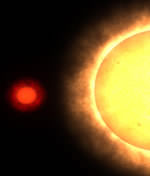
Image credit: NASA
NASA astronomers have discovered what they believe could be the third closest star to our own Sun. The star, now called SO25300.5+165258, is a faint red star estimated to be about 7.8 light years away in the constellation of Aries. This is just beyond Alpha Centauri (which is actually a group of three stars) and Bernard?s Star. This new star hasn?t been discovered until now because it only has 7% of the mass of our own Sun, and is 300,000 times fainter.
The local celestial neighborhood just got more crowded with a discovery of a star that may be the third closest to the Sun. The star, “SO25300.5+165258,” is a faint red dwarf star estimated to be about 7.8 light-years from Earth in the direction of the constellation Aries.
“Our new stellar neighbor is a pleasant surprise, since we weren’t looking for it,” said Dr. Bonnard Teegarden, an astrophysicist at NASA’s Goddard Space Flight Center, Greenbelt, Md. Teegarden is lead author of a paper announcing the discovery to be published by the Astrophysical Journal. This work has been done in close collaboration with Dr. Steven Pravdo of NASA’s Jet Propulsion Laboratory (JPL).
If its distance estimate is confirmed, the newfound star will be the Sun’s third-closest stellar neighbor, slightly farther than the Alpha Centauri system, actually a group of three stars a bit more than four light-years away, and Barnard’s star, about six light-years away. One light-year is almost six trillion miles, or nearly 9.5 trillion kilometers.
The new star has only about seven percent of the mass of the Sun, and it is 300,000 times fainter. The star’s feeble glow is the reason why it has not been seen until now, despite being relatively close.
“We discovered this star in September 2002 while searching for white dwarf stars in an unrelated program,” said Teegarden. The team was looking for white dwarf stars that move rapidly across the sky. Celestial objects with apparent rapid motion are called High Proper Motion (HPM) objects. A HPM object can be discovered in successive images of an area of sky because it noticeably shifts its position while its surroundings remain fixed. Since either a distant star moving quickly or a nearby star moving slower can exhibit the same HPM, astronomers must use other measurements to determine its distance from Earth.
During its star search, the team used the SkyMorph database for the Near Earth Asteroid Tracking (NEAT) program. NEAT is a NASA program, run by the Jet Propulsion Laboratory (JPL), Pasadena, Calif., to search for asteroids that might be on a collision course for Earth. SkyMorph was separately supported by NASA’s Applied Information Systems Research Program. Like HPM stars, asteroids reveal themselves when they shift their position against background stars in successive images. Automated telescopes scan the sky, accumulating thousands of images for the NEAT program, which have been incorporated into SkyMorph, a web-accessible database, for use in other types of astronomical research.
Once the star revealed itself in the NEAT images, the team found other images of the same patch of sky to establish a rough distance estimate by a technique called trigonometric parallax. This technique is used to calculate distances to relatively close stars. As the Earth progresses in its orbit around the Sun, the position of a nearby star will appear to shift compared to background stars much farther away — the larger the shift, the closer the star.
The team refined their initial distance estimate with another technique called photometric parallax. They used the 3.5-meter Astrophysical Research Consortium telescope at the Apache Point observatory, Sunspot, N.M., to observe the star and separate its light into its component colors for analysis. This allowed the team to determine what kind of star it is. The analysis indicates it’s similar to a red dwarf star (spectral type M6.5) that’s shining by fusing hydrogen atoms in its core, like our Sun (called a main sequence star).
Once the type of star is known, its true brightness, called intrinsic luminosity, can be determined. Since all light-emitting objects appear dimmer as distance from them increases, the team compared how bright the new star appeared in their images to its intrinsic luminosity to improve their distance estimate.
Although the star resembles a M6.5 red dwarf, it actually appears three times dimmer than expected for this kind of star at the initial distance estimate of 7.8 light-years. The star could therefore really be farther than the rough trigonometric distance indicates; or, if the initial estimate holds, it could have unusual properties that make it shine less brightly than typical M6.5 red dwarfs. A more precise measurement of the new star’s position to establish an improved trigonometric parallax distance is underway at the U.S. Naval Observatory. This will confirm or refute its status as one of our closest neighbors by late this year. Either way, we might get even more company soon: “Since the NEAT survey only covered a band of the sky (+/- 25 degrees in declination), it is entirely possible that other faint nearby objects remain to be discovered,” said Teegarden.
Original Source: NASA News Release
